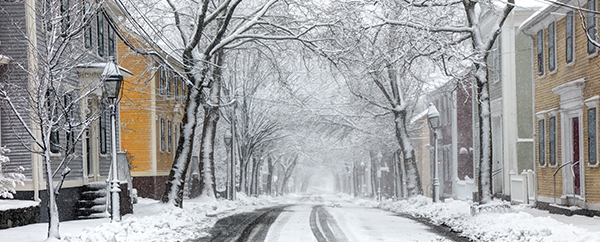Don’t get left in the cold! Use these winter weather preparation tips
- The most common types of winter weather damage are freezing pipes, ice damage to foundations or roofs and ice on walkways leading to slips and falls.
- Use our checklist to help prevent damage to roofs, gutters, entrances.
- What essential tools and other items to have on hand to combat bad weather.
- Learn tips to help keep your workers safe.
Winter weather has settled in. Due to the pandemic, many facilities are standing empty or are only partially in use, but that doesn’t mean they are exempt from winter weather preparation. Every year, winter’s precipitation and lower temperatures take a toll on facilities that can lead to costly property damage claims. However, proper care and maintenance strategies handled prior to winter conditions can drastically reduce their damaging effects, helping to reduce claims. Read on for winter weather preparation tips for your business.
Related: 10 ways to keep employees safe from winter work hazards
Winter weatherization preparation plans
Your company probably has an established plan for winter weather preparation, particularly if you reside in colder climates. Just what that plan entails will be unique to each location. Enterprises consisting of many facilities or locations should develop a plan that ensures a system of thorough maintenance checks and tasks tailored to the needs of each facility. Location-specific checklists that are completed before a certain deadline are a great way to get organized. Consider the following areas for inspection and preventative maintenance before winter weather hits.
Related: Steps to prevent winter property damage to roofs
Common types of winter weather damage
First, it’s important to identify exactly what kind of stressors can affect buildings during winter weather. Plunging temperatures will affect property exteriors, but if a building is not properly sealed and insulated against the cold, the interiors can be adversely affected as well. Valuable heat and energy can be lost through any leak, crack or other flaw in a building’s “envelope,” costing your company hefty sums in high heating bills. Poorly designed entryways and exits that see high volumes of traffic can also lead to higher energy costs. In addition, water systems are at high risk of freezing and bursting when a building is badly insulated or inefficiently heated.
Related: How to prevent cold stress in outdoor workers
Fluctuating outside temperatures can cause ground expansion and upheavals, which can result in damage to sidewalks, pavement and foundations. When the temperature warms up and causes snow and ice to thaw, water damage can occur anywhere water collects and pools if there’s no system for efficient drainage.
Your winter weather preparation checklist
Consider using the following checks to develop your essential winter weather preparation plan or to augment a plan that’s already in place:
- Roofs
- Determine the snow load capacity of each roof.
- Develop a procedure to monitor snow load levels during periods of heavy snowfall to prevent collapse and other structural damage.
- Before the first snow, inspect roof for any damage or debris, especially around vents and other apertures.
- Check seals near roof edges to identify any drafts and leaks.
- Remove any overhanging tree limbs that may damage the roof if they fall.
- Gutters
- Thoroughly clean and test gutters to ensure they’ll function as expected during periods of heavy precipitation or thaw.
- During the gutter test, observe the water accumulation under the spouts to ensure no erosion, seepage or other damage is occurring to building foundations or surrounding landscaping.
- Entrances and exits
- Inspect the seals of all windows, doorways and vents and handle any repairs before cold weather sets in.
- Ensure you have the proper floor mats available for each entrance and exit, and that they are clean and in good repair.
- Thoroughly clean permanently installed carpets around entrances and exits of dirt and other dry soil before wet conditions set in.
- Have water removal tools on hand to dry floors around entrances and exits as needed.
- Anticipate weather-related power losses and surges
- Review procedures to protect water pipes, critical data, inventory and other organizational assets that might be affected by a loss of power.
- In the event of prolonged power loss, identify which systems must have power. Acquire backup generators to keep them running.
- Have a basic inventory of parts and tools necessary to repair critical systems if professionals can’t reach you due to conditions.
- Inspect and conduct maintenance and repairs for all the following systems:
- Fire suppression
- Gas lines
- Water systems and related piping
- HVAC
- Building exteriors
- Flammable items in storage
In addition, be sure you have appropriate procedures in place for the following items:
- Ensuring adequate heat to buildings, especially vacant ones
- Snow and ice removal
- Schedules
- Weather monitoring
- Equipment inspection (shovels, snowblowers, etc.)
- Pre-determined snow removal zones
- Daily safety inspections to identify and mitigate any hazardous walking conditions as they develop
- Safety for workers that conduct tasks outdoors in winter conditions
- Outdoor shelters such as wind shields and outdoor radiators
- Work in shifts to limit outdoor exposure
- Schedule shifts for the warmest parts of the day
- Ensure proper attire
- Provide warm liquids
- Remind employees to stay well hydrated and not over-exert themselves
Related: Winterize your vehicles to minimize deep-freeze claims
Winter conditions will always inflict an expected amount of wear and tear on property, but your winter weather preparations can reduce the odds of sustaining costly damage. Have a safe and warm New Year!
This blogpost originally published in Arrowhead’s Tribal blog. It has been updated and modified to better fit the needs of Arrowhead Core Commercial producers and their business clients.

